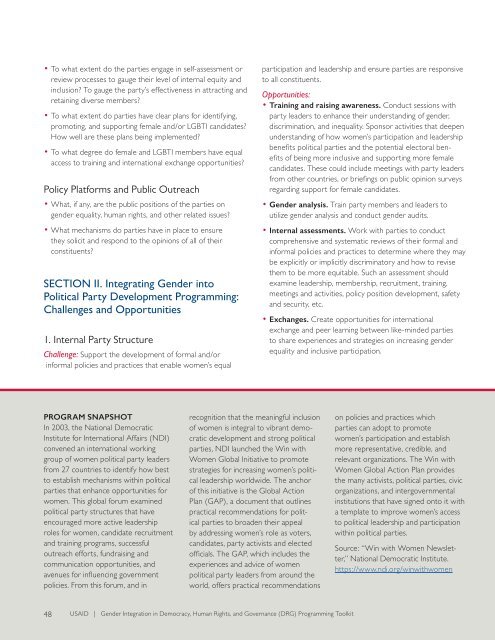Gender Integration
pbaae696
pbaae696
Create successful ePaper yourself
Turn your PDF publications into a flip-book with our unique Google optimized e-Paper software.
• To what extent do the parties engage in self-assessment or<br />
review processes to gauge their level of internal equity and<br />
inclusion? To gauge the party’s effectiveness in attracting and<br />
retaining diverse members?<br />
• To what extent do parties have clear plans for identifying,<br />
promoting, and supporting female and/or LGBTI candidates?<br />
How well are these plans being implemented?<br />
• To what degree do female and LGBTI members have equal<br />
access to training and international exchange opportunities?<br />
Policy Platforms and Public Outreach<br />
• What, if any, are the public positions of the parties on<br />
gender equality, human rights, and other related issues?<br />
• What mechanisms do parties have in place to ensure<br />
they solicit and respond to the opinions of all of their<br />
constituents?<br />
SECTION II. Integrating <strong>Gender</strong> into<br />
Political Party Development Programming:<br />
Challenges and Opportunities<br />
1. Internal Party Structure<br />
Challenge: Support the development of formal and/or<br />
informal policies and practices that enable women’s equal<br />
participation and leadership and ensure parties are responsive<br />
to all constituents.<br />
Opportunities:<br />
• Training and raising awareness. Conduct sessions with<br />
party leaders to enhance their understanding of gender,<br />
discrimination, and inequality. Sponsor activities that deepen<br />
understanding of how women’s participation and leadership<br />
benefits political parties and the potential electoral benefits<br />
of being more inclusive and supporting more female<br />
candidates. These could include meetings with party leaders<br />
from other countries, or briefings on public opinion surveys<br />
regarding support for female candidates.<br />
• <strong>Gender</strong> analysis. Train party members and leaders to<br />
utilize gender analysis and conduct gender audits.<br />
• Internal assessments. Work with parties to conduct<br />
comprehensive and systematic reviews of their formal and<br />
informal policies and practices to determine where they may<br />
be explicitly or implicitly discriminatory and how to revise<br />
them to be more equitable. Such an assessment should<br />
examine leadership, membership, recruitment, training,<br />
meetings and activities, policy position development, safety<br />
and security, etc.<br />
• Exchanges. Create opportunities for international<br />
exchange and peer learning between like-minded parties<br />
to share experiences and strategies on increasing gender<br />
equality and inclusive participation.<br />
PROGRAM SNAPSHOT<br />
In 2003, the National Democratic<br />
Institute for International Affairs (NDI)<br />
convened an international working<br />
group of women political party leaders<br />
from 27 countries to identify how best<br />
to establish mechanisms within political<br />
parties that enhance opportunities for<br />
women. This global forum examined<br />
political party structures that have<br />
encouraged more active leadership<br />
roles for women, candidate recruitment<br />
and training programs, successful<br />
outreach efforts, fundraising and<br />
communication opportunities, and<br />
avenues for influencing government<br />
policies. From this forum, and in<br />
recognition that the meaningful inclusion<br />
of women is integral to vibrant democratic<br />
development and strong political<br />
parties, NDI launched the Win with<br />
Women Global Initiative to promote<br />
strategies for increasing women’s political<br />
leadership worldwide. The anchor<br />
of this initiative is the Global Action<br />
Plan (GAP), a document that outlines<br />
practical recommendations for political<br />
parties to broaden their appeal<br />
by addressing women’s role as voters,<br />
candidates, party activists and elected<br />
officials. The GAP, which includes the<br />
experiences and advice of women<br />
political party leaders from around the<br />
world, offers practical recommendations<br />
on policies and practices which<br />
parties can adopt to promote<br />
women’s participation and establish<br />
more representative, credible, and<br />
relevant organizations. The Win with<br />
Women Global Action Plan provides<br />
the many activists, political parties, civic<br />
organizations, and intergovernmental<br />
institutions that have signed onto it with<br />
a template to improve women’s access<br />
to political leadership and participation<br />
within political parties.<br />
Source: “Win with Women Newsletter,”<br />
National Democratic Institute.<br />
https://www.ndi.org/winwithwomen<br />
48<br />
USAID | <strong>Gender</strong> <strong>Integration</strong> in Democracy, Human Rights, and Governance (DRG) Programming Toolkit

















